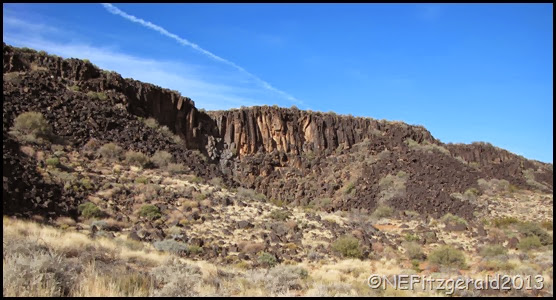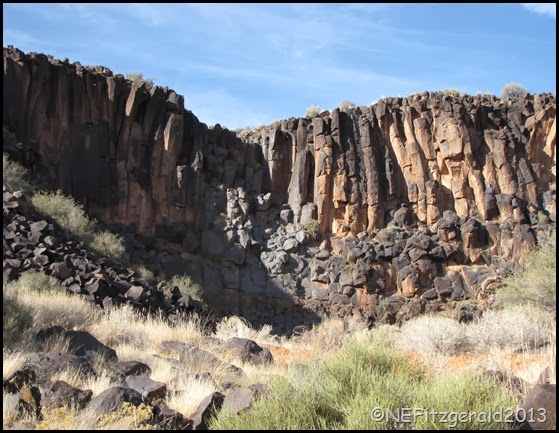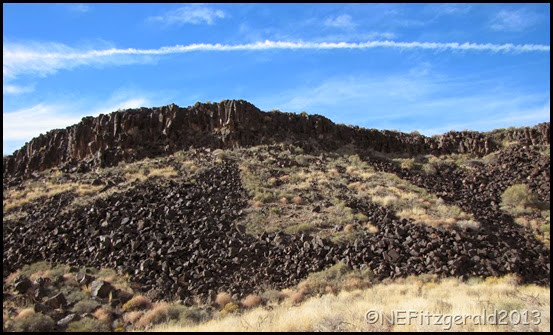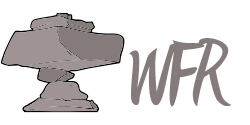Rocks certainly come in a lot of unique shapes and sizes, and one of the most intriguing rocks of all is basalt that displays “columnar jointing.” And one of the most common questions asked about these distinctively–shaped edifices is “How in the heck did this happen?”
 |
| Columnar jointing in basalt, Red Cliffs Desert Reserve |
A lot of lava flows have come and gone in southern Utah, and you don’t have to wander very far to find eye–catching evidence of volcanic activity. When molten lava stops flowing and cools quickly it forms basalt, a fine–grained igneous rock. But why does some lava cool into columns of basalt and not blocky aa or ropy pahoehoe?
 |
| Columnar jointing in basalt |
Columns are actually found in many types of cooled igneous features: lava flows, sills, dikes, ash flow tuffs, and shallow intrusions of every composition. Piles of these columns are abundant around the world, and the Red Cliffs Desert Reserve is a particularly fine place to find them. The other day I cajoled my hiking buddy JO into an afternoon stroll along the Grapevine Wash/Bracken’s Loop trail to photograph some impressive basalt outcrops I’ve had my eye on.
 |
| Grapevine-Bracken’s Loop trail |
For years, the only explanation I could wrangle from anyone or anywhere is that these columns formed as a result of how the basalt cooled. That’s all? I knew there had to be more to the explanation – the whythis happens – but I just couldn’t seem to put my finger on it.
Until yesterday.
Until yesterday all I knew was that, as the lava cools, it contracts and forms fractures or cracks. Cooling = fractures (also called joints). Everyone had told me that! When I realized that growth of the cracks is perpendicular to the surface of the lava flow I knew I was on to something.
 |
| Eroding cliffs of columnar basalt |
I don’t often quote directly from a source but generally try to rephrase things in my own words from my own head. But sometimes I find that a particular source just says it better than I ever could. So it is with this excellent explanation from the National Park Service Devil’s Postpile web site of why columnar jointing forms:
“As the lava flow ceased, the molten rock began cooling into solid rock. Shallow parts of the lava flow would have solidified first, with deeper parts of the lava lake requiring much more time to release the massive amount of stored thermal energy. As the lava lake cooled and solidified from a molten soup to solid rock it began to contract. Contraction stresses developed because the cool solid form of basalt has a lesser volume than the hot liquid form. Cracks, also called joints by geologists, began to form. Jointing releases internal stress created by the cooling and associated contraction. In some locations, such as at the Devils Postpile, the jointing formed columns. Jointing would have begun at the top, bottom and all around the edges of the lava lake where the lava made direct contact with a cooler surface. The cracks would have extended inwards over time as the more insulated locations within the lava lake finally released enough thermal energy to change from a liquid to a solid state.”
 |
| Grapevine-Bracken’s Loop trail leads to cliffs of columnar basalt |
Finally! Here is the reason the joints (or cracks) occur. It’s simple physics! It is all about how the lava cools, about hot vs. cold! And leave it to the National Park Service to offer the best explanation. Another site also offers easy–to–understand explanations and diagrams of this fascinating phenomenon.
Where have you seen any examples of columnar jointing in your travels?



